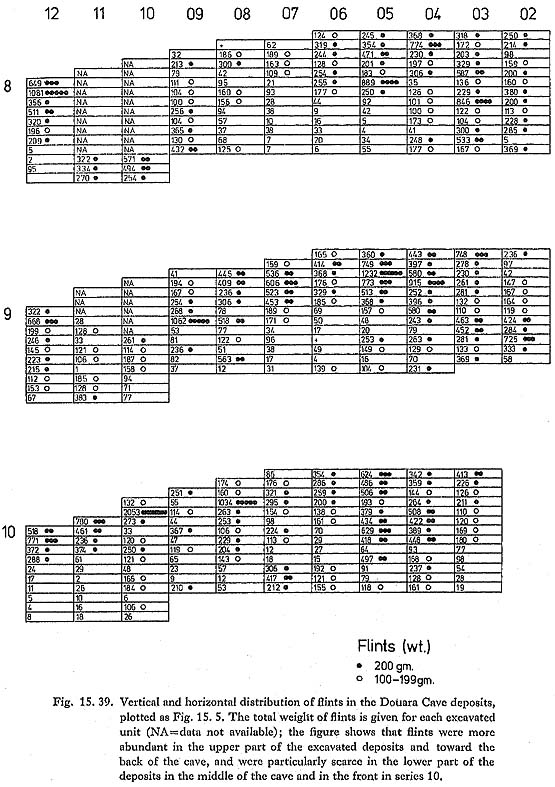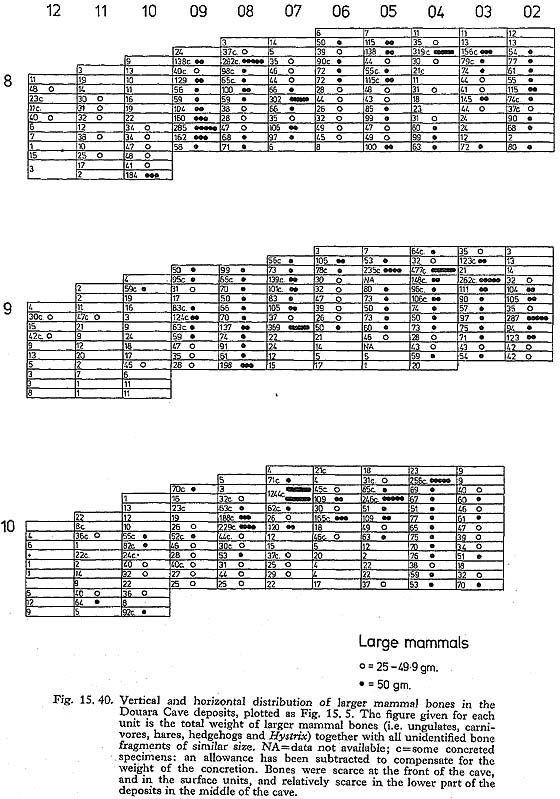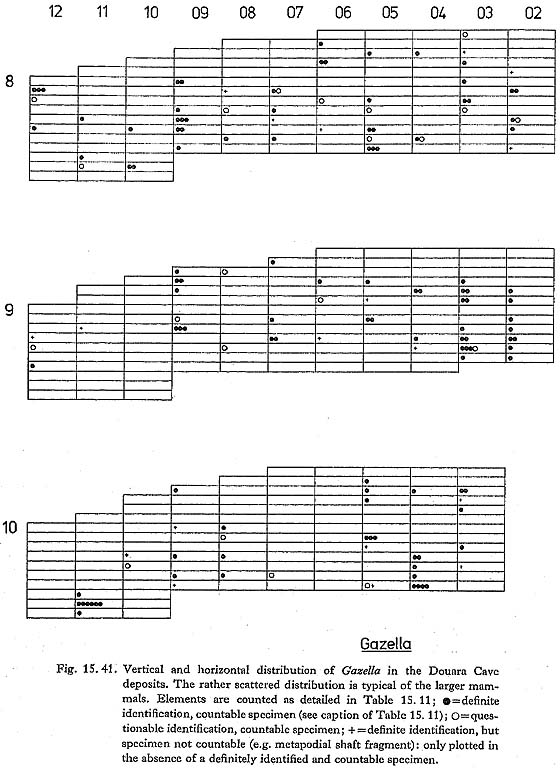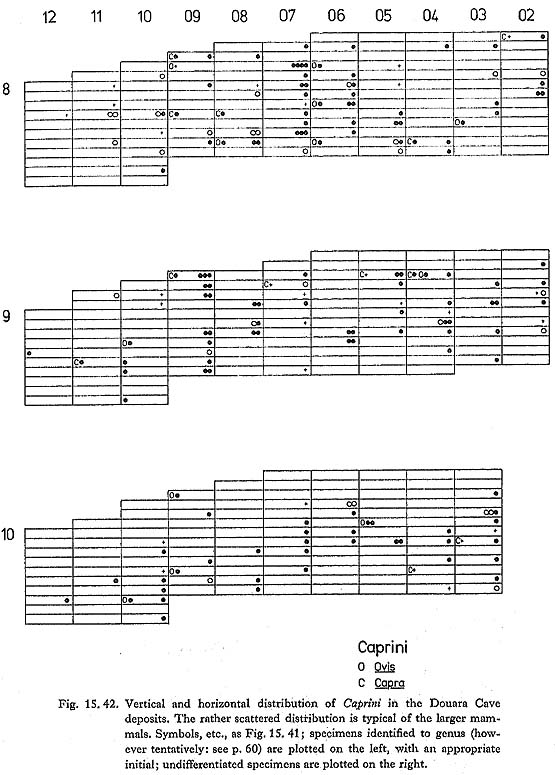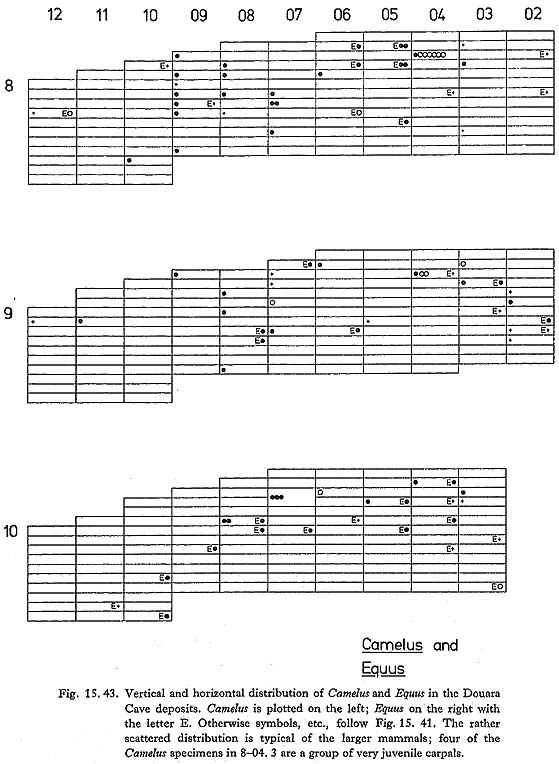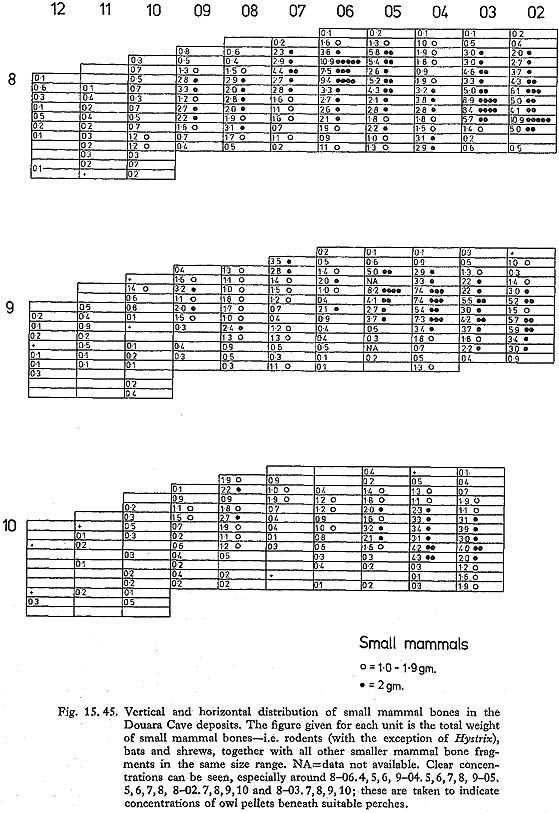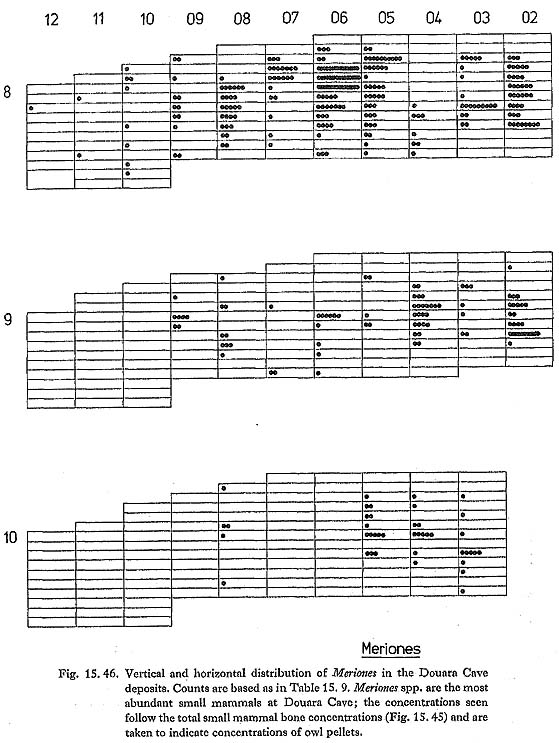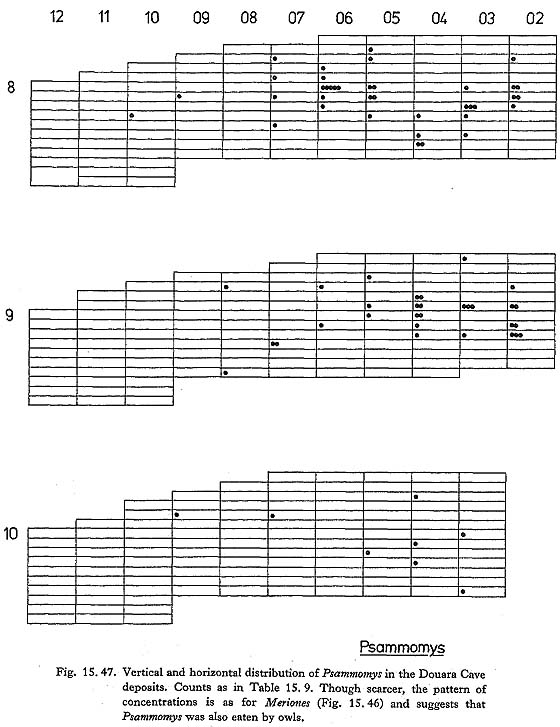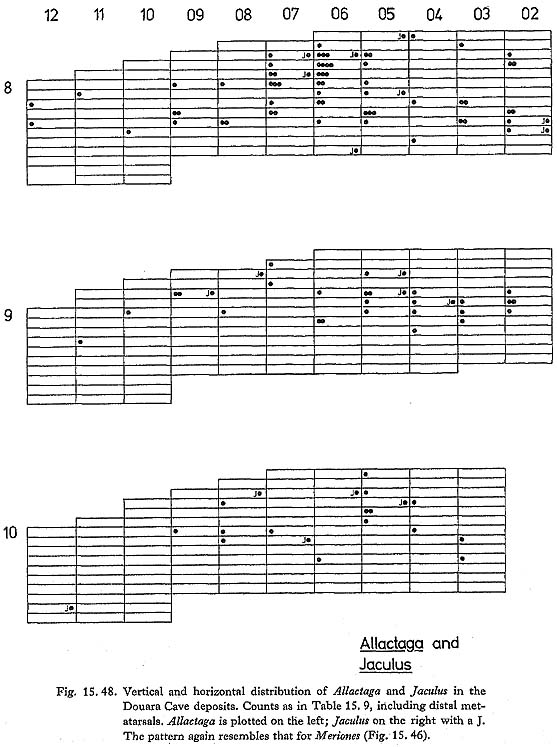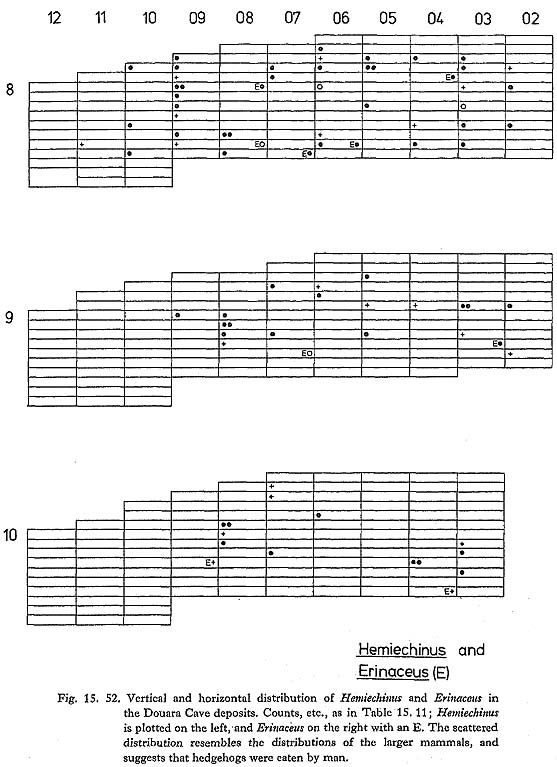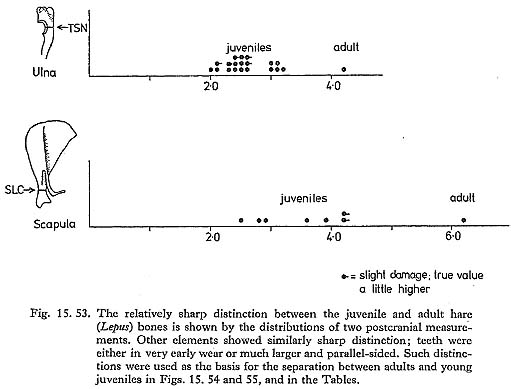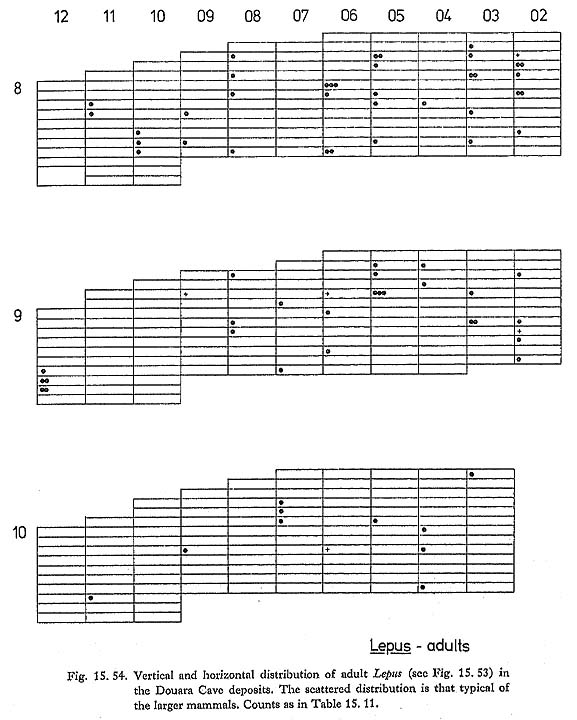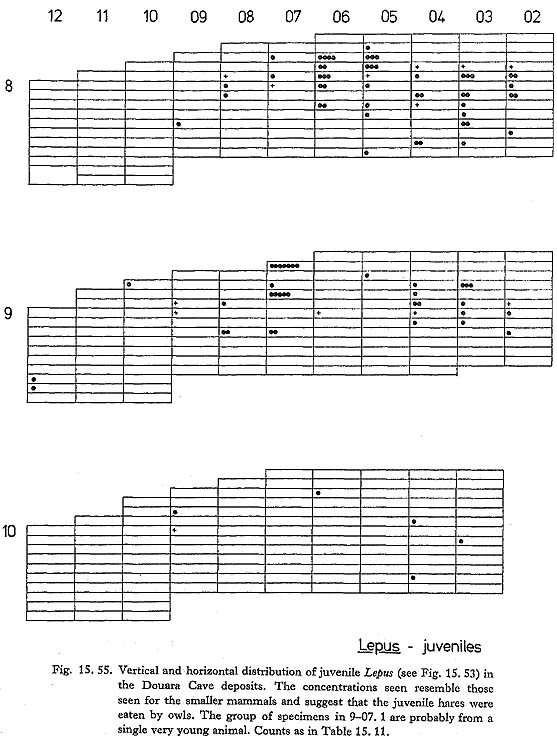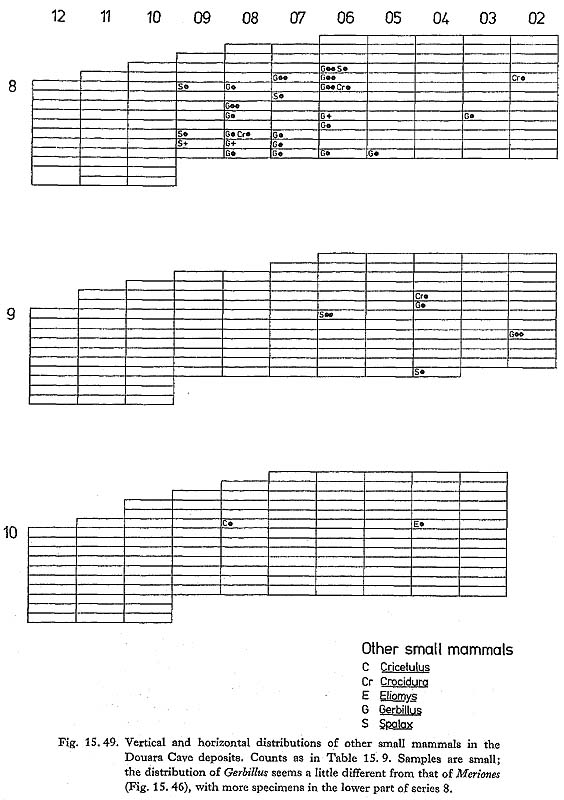CHAPTER 15
The Animal Bones from the 1974 Excavations at Douara Cave
Sebastian Payne
Trinity Collage, University of Cambridge
| ( 6 / 10 ) |
15.3 INTERPRETATION15. 3.1 Sources of the bonesMany of the bones found in the cave are undoubtedly food remains left by man, as evidenced by cut-marks and by other remains of human occupation, such as hearths and flint tools. Other bones, however, may be the food remains of cave-living animals, such as lions, wolves, foxes, porcupines or owls; or they may be the remains of animals that died in the cave, such as bats. Owls in particular commonly roost in caves, and their regurgitated pellets are rich in small mammal remains. In reconstructing environmental conditions, a sample of bones from a cave cannot simply be treated as a representative sample of the animals that lived around the cave. Instead, it must be seen as a selective accumulation; and the more the process of selection and accumulation is understood, the better the chance that conclusions based on that sample will be reliable. In this context, a sample accumulated by a number of different agencies is an advantage. All hunters are selective, and if all we had was a sample of the animals brought back to a cave by man, we would run the risk that man's selection of which areas around the cave to hunt, of which animals to hunt, and of which of these to bring back to the cave, might give a limited and unrepresentative picture of the area around the cave. Adding to this sample the animals brought back to the cave by other predators, such as owls, offers the possibility that a wider range of local biotopes will be sampled, and a wider range of species taken, and thus makes environmental reconstruction more reliable, even though the different biases cannot be taken as canceling each other out. The different ranges of different predators also have to be taken into consideration: owls, for instance, usually hunt within a radius of 1-3 km, and their prey will thus reflect the biotopes within this area; while man's hunting range is very much larger, and may thus include a wider range of biotopes. In looking at human subsistence and technology, however, a mixture of different sources creates problems, as we need to know which bones are man's food remains and which were brought into the cave in other ways. In trying to decide who ate what, cut-marks provide one obvious source of evidence; but these marks are scarce in the Douara Cave sample. Only a small handful of specimens carry cut-marks, and nearly all of these are scraps of medium-sized ribs and long-bone shaft fragments. Gnawing-marks, such as might be left by carnivores or by porcupines, are even scarcer, and would in any case be less definite in their implications, as they might result from scavenging by animals among man's food remains. The scarcity of gnawing-marks, however, can probably be taken as evidence that large carnivores did not play an important part in the accumulation of the Douara Cave bones. Burnt bones are another potential source of evidence, but caution is needed, as bones can be accidentally burnt when a fire is lit on top of them. The lower part of the deposits excavated in 1974 in the middle and inner part of the cave is essentially one large hearth (Fig. 15. 4), and most of the bones found in that part of the deposits are burnt, some very intensely, including rodent and bat bones. In contrast, burnt bones and hearth traces are relatively scarce in the upper part of the deposit, but flints and bones are more abundant (Figs. 15. 39 and 40). It seems that the difference in the amount of burning does not reflect any change in the intensity of human occupation; possible explanations include a shift in preferred location of the fireplace to the area in front of the cave and the less frequent use of fire.
Another source of evidence is provided by the vertical and horizontal distribution of different components of the animal bone sample, and here the evidence is more helpful. As Figs. 15. 39 and 40 show, the distributions of flints and of large mammal bones are fairly well scattered. Overall, both flints and large mammal bones are more abundant in the upper part of the deposits than lower down; flints are also more common toward the back of the cave, and large mammal bones are very scarce in the front three sets of meter squares and in the top one or two units in each square (this probably as a result of poor preservation: see below, p. 81). We find, however, considerable variation between adjacent units, no consistent pattern of local concentrations, and little detailed correlation between units with more flint and units with more bone. The distributions of bones of the larger mammals, such as Gazella (Fig. 15. 41), Caprini (Fig. 15. 42), Equus and Camelus (Fig. 15. 43), and Carnivora (Fig. 15. 44) reflect this well scattered distribution, and there is no reason to think that these animals were not brought to the cave by man. In marked contrast, the distribution of smaller mammal bones (Fig. 15. 45) shows a clear pattern of small-scale concentrations, reflected in detail by the distribu tions of the different rodent genera, e.g. Meriones (Fig. 15. 46), Psammomys (Fig. 15. 47), Allactaga and Jaculus (Fig. 15. 48), as well as by the distributions of lizard bones (Fig. 15. 50) and bird bones (Fig. 15. 51). The good condition of these small bones is consistent with their having come from owl pellets (bones from diurnal raptor pellets are usually very much more corroded and fragmented, as also are any small bones that pass through the digestive tracts of mammalian carnivores), and this provides the simplest explanation for these concentrations of small bones-that they show where owl pellets accumulated below suitable perches in the roof of the cave.
Hedgehog bones (Fig. 15. 52) are well scattered, suggesting that the hedgehogs were eaten by man rather than by owls; this is not surprising, as hedgehog bones are only occasionally found in modern owl pellets, presumably because owls find the spines of hedgehogs difficult to cope with.
The distribution of hare bones is of particular interest. The Douara Cave hare bones separate rather clearly into younger juveniles and adults, with few intermediate specimens (Fig. 15. 53), and the two categories appear to be differently distributed. Adult hare bones (Fig. 15. 54) are well scattered, and are taken to have been eaten by man; younger juveniles (Fig. 15. 55) seem to be concentrated in much the same areas as the smaller rodent and other small bones, and are taken as having probably been eaten by the owls.
Bat bones (Fig, 15. 56) again show a pattern of small-scale concentration, but in a different place, at the bottom of the excavated section in squares 8-05 and 06. This can probably be taken to reflect the accumulation of dead animals below a bat-roost in a fissure in the roof of the cave. Three components of the Douara Cave bone sample can thus be recognized on the basis of different patterns of distribution within the deposits:
Distribution data for some of the scarcer species are scanty, but a reasonable guess can be made as to the component to which they belong. The distribution of Gerbillus (Fig. 15.49) differs somewhat from that of the other smaller rodents, but it is provisionally grouped with them.
Spalax presents more of a problem; the available data are scanty and unclear (Fig. 15. 49). Spalax is a specialized burrower, and, as Turnbull and Reed (1974) comment, is more likely to be taken by man than by owls; it is, however, sometimes found in modern owl pellets. |
